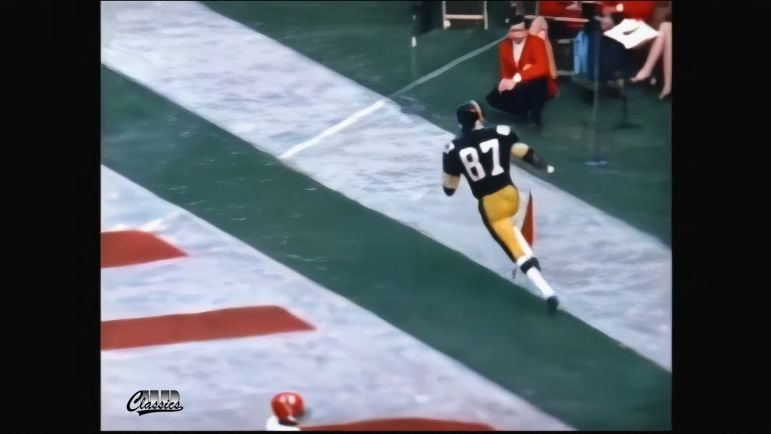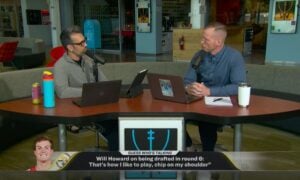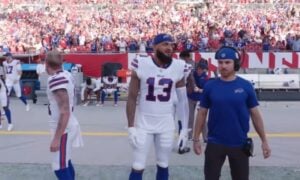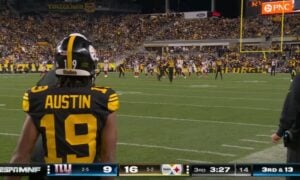Roy Jefferson didn’t unfollow the Pittsburgh Steelers on Instagram. His weekly fines weren’t publicly issued by the NFL. There wasn’t any 24/7 media coverage and reaction to every move he made. But the story of the “diva” receiver is a tale as old as time. George Pickens is the latest example of that but in Steelers history, Jefferson was the first.
Like Pickens, Jefferson was a supremely talented receiver of his time. Drafted by the San Diego Chargers and Steelers in the 1965 AFL and NFL drafts (the two would merge in 1967, now known as the “common draft” era), Jefferson chose to play in Pittsburgh. His impact was immediate. He caught just 13 passes as a rookie but averaged over 22 yards per reception with his first touchdown while serving as the Steelers’ primary punt returner.
By 1966, he was Pittsburgh’s No. 1 receiver. As an NFL sophomore, he led the team – and league – in yards per reception at 24.1. His 32 receptions turned into 772 yards. Jefferson could hit the home run, highlighted by an 84-yard score in a 17-3 win over the Detroit Lions. At the time, it was the fourth-longest passing touchdown in Steelers history.
Jefferson became the team’s second-ever 1,000-yard receiver with his 1968 campaign and the first Steeler to do it back-to-back thanks to his 1,079 yards the following year. He became the team’s number one source of points, finding the end zone 22 times over that span, including an 80-yard punt return touchdown in a 28-28 tie versus the St. Louis Cardinals. Jefferson was named a Pro Bowler in each season.
In one game against the Atlanta Falcons in 1968, Jefferson caught four touchdown passes in a 41-21 rout. Hines Ward never did it. Nor did Antonio Brown, Lynn Swann, or John Stallworth. Jefferson is the only Steeler to ever achieve the feat.
When Chuck Noll took over in 1969, the Steelers were lovable losers. To Noll, they were just the latter. A poor roster without talent playing uncompetitive football. In his first year, Pittsburgh won its season opened followed by 13-straight losses. But talent-wise, Jefferson was the bright spot. As Noll built the roster in his vision, surely he would keep his star receiver.
Instead, Noll traded him to Baltimore. For all of Jefferson’s talent, he and Noll clashed. Trade details reported by the New York Times highlighted the problems.
“Jefferson, 26, had irked Noll in little ways. He was sent home from Montreal before a preseason game against the Giants last summer after he had stayed out past the curfew hour.
In training camp this summer he came to practice without a helmet and parked his car in a forbidden area. As the Steelers player representative, he also had expressed displeasure in the outcome of the recent players strike.”
Like Pickens, Jefferson wasn’t an issue with the law. Never arrested, never in that sort of trouble. But Noll drew a hard line over player conduct, moreso than Mike Tomlin, especially as he changed the culture of the team as the bedrock of the upcoming dynasty.
In return, Pittsburgh received veteran receiver Willie Richardson. Falling out of favor with Baltimore’s coaching staff, Noll choosing to add him while sending Jefferson out the door seemed curious. But Noll showed little patience for Richardson either and, as once outlined by Steelers.com’s Bob Labriola, soon sent him packing, too.
‘[Richardson] sought to re-negotiate his contract before reporting to the team,” Labriola wrote last year. “Dan Rooney refused that request, and so Richardson didn’t report to the team. Then he did report and stayed long enough to catch 4 passes for 62 yards in the preseason and tried again to re-negotiate, but Noll apparently had tired of this whole back-and-forth and traded Richardson to Miami for a fifth-round pick in the same 1971 draft that would bring the team [Dwight White] in the fourth round.”
Jefferson played just one season in Baltimore before spending his final six in Washington. He made the Pro Bowl in 1971, though his production never repeated the peak it showed in Pittsburgh. He retired after the 1976 season.
The more things change, the more they stay the same. Antonio Brown, Chase Claypool, and Diontae Johnson all can be compared to George Pickens. Talented players (some more than Pickens, some less so) eventually traded when the headaches they caused surpassed the plays they made. Pickens won’t be the last. But the first came nearly 60 years ago.








